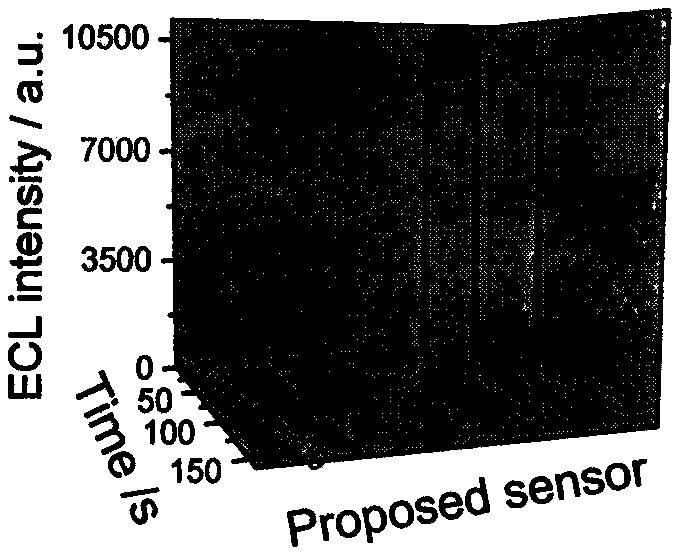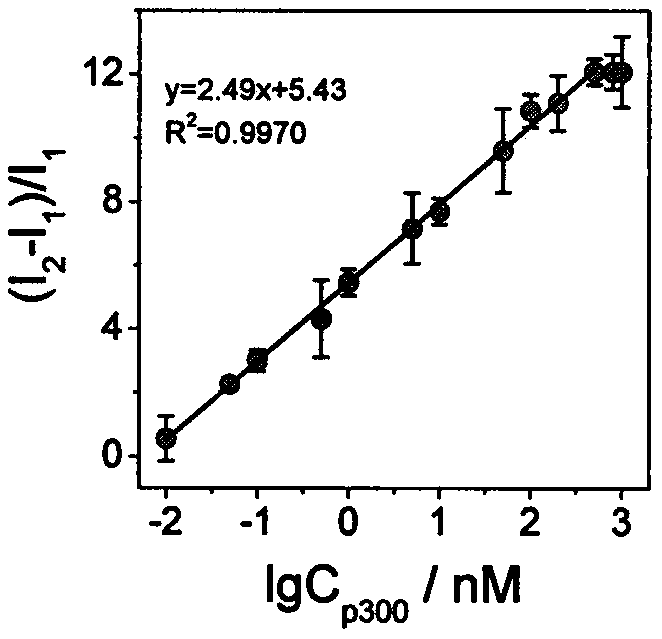Electrochemical synthesis-based acetyl transferase electrochemical light-emitting sensor built by Ru-MOF and application of acetyl transferase electrochemical light-emitting sensor
An acetyltransferase and electrochemical technology, which is applied in the field of functional biomaterials and biosensing, can solve the problems of undisclosed acetyltransferase electrochemiluminescence sensors, etc., and achieve the effects of good selectivity, high sensitivity, and low dosage
- Summary
- Abstract
- Description
- Claims
- Application Information
AI Technical Summary
Problems solved by technology
Method used
Image
Examples
Embodiment 1
[0034] Embodiment 1 Preparation of sensor
[0035] The technical scheme adopted by the present invention to solve the above-mentioned technical problems is: construct an acetyltransferase electrochemiluminescent sensor and its application based on electrochemically synthesized Ru-MOF, and the specific steps are as follows:
[0036] Preparation of Electrode 1:
[0037] First, the glassy carbon electrode (GCE, 3 mm in diameter) was polished on the suede with Al2O3 powder (0.05 μm) for 5 min. N 2 Blow dry to get a bare glassy carbon electrode. Labeled Electrode 1.
[0038] Preparation of Electrode 2:
[0039] Liquid A: ZnCl 2 (0.9mmol, 0.123g), KNO 3 (0.1M, 0.0303g), dissolved in 3mL of water. Solution B: Dissolve trimesic acid (0.5 mmol, 0.105 g) in 3 mL of ethanol.
[0040] Solution A and solution B are mixed at room temperature, 5mmol of Ru(bpy) 3 2+ Add in the mixture of A and B, under vigorous stirring, stir at room temperature for 3h. The solution is ready for us...
Embodiment 2
[0045] Embodiment 2 Feasibility experiment
[0046] The technical solution adopted by the present invention to solve the above technical problems is: a kind of electrochemically synthesized Ru-MOF based on electrochemically synthesized acetyltransferase electrochemiluminescence sensor and its application, the specific steps are as follows:
[0047] (1) Electrode 1-Electrode 4 were prepared as in Example 1, and their electrochemiluminescence responses in PBS (0.1 M, pH 7.0, containing 0.1 M KCl and 100 mM triethanolamine) solution were detected. Using the BPCL T15 measurement and analysis system, set the high voltage to 800V, the scan rate to 100mV / s, and the scan voltage to 0-1.35V. from figure 1 It can be seen that Electrode 2 has an obvious electrochemical response signal in PBS (0.1M, pH 7.0, containing 0.1M KCl and 100mM triethanolamine), which proves that Ru-MOF was successfully synthesized. Electrode 4 also has an obvious electrochemiluminescence response signal, and t...
Embodiment 3
[0049] Example 3 Detection of p300 activity
[0050] In the preparation process of Example 1 Electrode 4, the concentration of p300 was changed, and the final concentration of p300 was controlled to be: 0, 0.01, 0.05, 0.1, 0.5, 1, 5, 10, 50, 100, 200, 500, 800, 1000nM, such as Example 1 Prepare a series of electrochemiluminescent sensors. Experimental results such as image 3 As shown, the Cu(II)-quenched ECL signal recovered more with increasing p300 concentration. The linear correlation equation of the luminous intensity of the sensor to the logarithmic value of the p300 concentration is y=2.49x+5.43, R 2 =0.9970, the linear range is 0.01-500nM, and the detection limit is 0.001nM, indicating that the sensor can realize wide-range and high-sensitivity detection of p300 activity.
PUM
| Property | Measurement | Unit |
|---|---|---|
| Diameter | aaaaa | aaaaa |
Abstract
Description
Claims
Application Information
 Login to View More
Login to View More - R&D
- Intellectual Property
- Life Sciences
- Materials
- Tech Scout
- Unparalleled Data Quality
- Higher Quality Content
- 60% Fewer Hallucinations
Browse by: Latest US Patents, China's latest patents, Technical Efficacy Thesaurus, Application Domain, Technology Topic, Popular Technical Reports.
© 2025 PatSnap. All rights reserved.Legal|Privacy policy|Modern Slavery Act Transparency Statement|Sitemap|About US| Contact US: help@patsnap.com



